VC&G Interview: Carol Shaw, Atari’s First Female Video Game Developer
October 12th, 2011 by Benj Edwards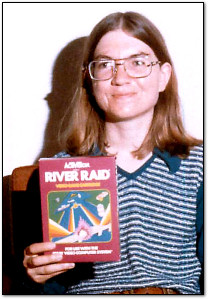 Carol Shaw likes to stress that she isn’t your average American woman. Growing up in a world of technology and science traditionally guided by men, she ignored implicit gender barriers and pursued what came to her naturally.
Carol Shaw likes to stress that she isn’t your average American woman. Growing up in a world of technology and science traditionally guided by men, she ignored implicit gender barriers and pursued what came to her naturally.
She says she had little interest in dolls as a kid, instead preferring to tinker with her brothers’ model railroad layout. In school, she proudly excelled in math and found herself gravitating toward computer science in college, a field of study populated by few women in the 1970s.
Two degrees later, Shaw landed a job at Atari programming games for the company’s new VCS console. She didn’t know it at the time, but she had just become one of the world’s first female professional video game designers.
Shaw enjoyed a short but fruitful career in video games that lasted from 1978 to 1984, stretching between two prominent California companies: Atari, of course, which all but founded the video game industry; and Activision, a firm most notable as the very first third-party video game software publisher.
During her time at Activision, Carol Shaw created River Raid, a title almost universally regarded as a masterpiece of game design for the Atari 2600 console.
For decades, Shaw downplayed her role in video game history. Now 56, she seems ready to embrace that part of her life, although she does not actively seek attention or fame. In that regard, we are fortunate that she accepted my request for an interview.
In May of this year, Shaw and I spoke for nearly two hours over the telephone in a career-spanning discussion that touched on her educational background, her time at Atari, Activision, and Tandem Computers, and her reflections on being a woman in a historically male-dominated industry. She also generously provided many of the rare photos you’ll see below.
It’s a long piece, but I think you’ll enjoy reading the extended thoughts of this pioneering software engineer.

Personal Background
Benj Edwards: When and where you were born?
 Carol Shaw: In Palo Alto, California in 1955. I was born and raised there.
Carol Shaw: In Palo Alto, California in 1955. I was born and raised there.
BE: How did you get interested in computers?
CS: It first started in high school. They had a time sharing system with BASIC. You’d type in BASIC programs on teletypes, and I also discovered they had games on the system that you could play, like Star Trek. Of course, they were text-based games.
BE: Was that the first computer you ever used?
CS: Yeah, that was in high school. It was funny — in the math class they would assign us to write a little program, and at first I was somewhat intimidated about going into the computer room, because it seemed like it was mostly boys using the computers.
The concept that your program will probably have bugs — that you’ll have to debug it — didn’t occur to me at first. I said, “I wrote this program to do a simple calculation, and I know what it will do.” So at first I didn’t even type it in. But later I started typing it in and got into doing the programming and playing the games.
BE: Did you go to college?
CS: I went to UC Berkeley. At first, I didn’t know what I wanted to major in. I tried different things, and I took a civil engineering course where we did surveying with steel tapes.
Then I took a programming course. In the first one, they used punch cards and Fortran, so you had to wait an hour to get your job back after it was stuck into the card reader. You had to be very careful that you had as few mistakes as possible, because you had to wait for the turnaround.
 BE: When did you decide on your major?
BE: When did you decide on your major?
CS: I can’t remember exactly when. I started out in the College of Letters and Science, and then I transferred to the College of Engineering. They did have a computer degree in Letters and Science, but they had a degree in electrical engineering and computer science in Engineering, so that’s what I ended up getting, a BS in that. I took a lot of computer courses, so the emphasis was on software rather than on hardware, but I did take some hardware courses.
BE: So by that time you’d found that you were interested in engineering as a possible career?
CS: It’s something I liked doing that I could get a job doing after I graduated.
BE: Did your parents do any engineering?
CS: Yes. My father was a mechanical engineer. His last job was at SLAC, the Stanford Linear Accelerator Center. He worked at Varian for a while, and some other companies.
My mother was a stay-at-home mom until my father got laid off one time. My mother started working at the Stanford library. She worked in serial records, so she would check-in the periodicals and the magazines that they ordered and renew the subscriptions.
BE: Was your mother interested in math or science in any way?
CS: I don’t think she was into it that much. I think maybe she had a teaching degree or something — I forget. My parents met at Syracuse University in New York.
BE: When you decided to go into engineering, being a woman, did your parents think that was odd in any way?
CS: No, I think they encouraged me. When I was in junior high and high school, I was good at math. I entered a bunch of math contests and won awards. Of course, people would say, “Gee, you’re good at math — for a girl.” That was kind of annoying. Why shouldn’t girls be good at math?
BE: Did you finish your degree at Berkeley?
CS: Yes, I got a BS in 1977, and then I went on to get a master’s degree in Computer Science at Berkeley and that was a one year master’s program, so it was just straight computer science courses. I interviewed at Atari while I was finishing the coursework.

Joining Atari
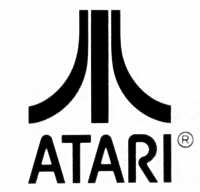
BE: Was Atari the first company you interviewed with after college?
CS: I interviewed with a bunch of companies, so I had several offers, but the one with Atari — that looked fun. I got paid to play games. [laughs]
BE: Had you played video games before that time?
CS: Yeah. We used to go miniature golfing and the miniature golf course had a game room with arcade games. The first one they had was Computer Space, which I think actually came out before Pong, but it was considered too complicated and didn’t catch on. So we would have two people play: one person would control the space ship, and the other person would do the firing. That way, we were able to manage all the buttons.
BE: So you played the very first commercial arcade game, Computer Space.
CS: They also had “Space Wars” over at the Stanford Student Union. [Called “The Galaxy Game,” installed in 1971 — ed.] That was even earlier.
Later, they got more arcade games at the miniature golf course. I think we played some of those before I went to Atari.
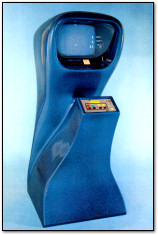 And then I had a dedicated game from Radio Shack that I hooked up to my black and white television set that could play a game similar to Pong. It didn’t have cartridges; it just had a couple of built-in games. So I had some experience playing games and I liked them.
And then I had a dedicated game from Radio Shack that I hooked up to my black and white television set that could play a game similar to Pong. It didn’t have cartridges; it just had a couple of built-in games. So I had some experience playing games and I liked them.
I’d never actually written a video game, but Atari hired me because I had the programming experience — and also, Berkeley had this engineering cooperative work study program where you’d work six months full-time at a high-tech company, then you’d go back to school for six months full time. I did assembly language programming for ESL in 1975 and then I worked for Amdahl in ’76 and then I had a summer job working for a little start-up company called muPro. So I had a lot of assembly language programming experience from those jobs, so that really helped me getting the job offers.
BE: Did Atari come to you, or did you approach them?
CS: I think they were interviewing on campus. I interviewed with them along with a number of other companies. I can’t remember exactly how I found out about the job, but they probably were doing on-campus interviews or at least advertising on campus. I was finishing up my coursework, and they offered me a job, and I accepted.
BE: Who did you interview with at Atari?
CS: I remember I talked to Al Miller. He was doing a Hangman game [for the Atari 2600], so I played that.
BE: What was the interview process like? Did you visit Atari?
CS: Yeah, I went to Atari. I visited their office, played the games, and interviewed — I don’t remember too much about the interview.
BE: Did they mention anything about you being a woman as being something different or unusual at the time?
CS: Not when I interviewed. It was later. One time when I was working in the lab, Ray Kassar, President of Atari, was touring the labs and he said, “Oh, at last! We have a female game designer. She can do cosmetics color matching and interior decorating cartridges!” Which are two subjects I had absolutely no interest in, so…
BE: Did that bother you, what he said?
CS: Later, the other guys said, “Don’t pay any attention to him. Do whatever you want to do.” It wasn’t like there was discrimination among the other game designers or anything.
BE: Were there other women working at Atari that weren’t game designers?
CS: Yeah, one of the women was working on the technical writing. They had a manual for Atari BASIC [for the Atari 800] and somebody wrote sort of a cutesy manual that was supposed to be very humorous, but it had a lot of technical errors in it. I ended up rewriting the manual. I don’t know, maybe the humorous approach would have been okay. We wanted it to be accurate.
BE: How did it feel to be the only woman game designer there?
CS: I didn’t really think about it too much because I’d been used to not having a lot of women in my computer science classes. I mean, there were a few. In the surveying class I took, it was the second quarter that the professor had women in his class — I think he made some comment about just starting to get women in those fields.
BE: Were you aware of any women in the game industry at the time when you worked at Atari?
CS: No, I wasn’t aware of any. Dona Bailey worked in coin-op. [Editor’s Note: Dona Bailey confirmed via email that she started at Atari in May-June 1980.]
I don’t remember ever meeting her, though. I was in the home video game division. There wasn’t a lot of contact between us and coin-op, even though they were downstairs in the same building. I think they were kind of secretive. They didn’t want the competitors of Atari to find out what they were doing.
BE: Did it occur to you at the time that you may have been world’s first female video game designer?
CS: It was only later people started saying that, and I’ve never really been able to verify it. I was looking at the thing you did — 10 Women Game Designers — and some of them were starting maybe a little bit after that time. I started in the summer of ’78 — August of ’78. I don’t know exactly when they started doing it. Because the Apple I came out — what was it, ’77 or something?
BE: 1976.
CS: Yeah, the Apple I came out in ’76, and the Apple II came out in ’77, so I don’t know if there was anybody doing games for that.
BE: It’s possible. But you’re the first one I know of. [Editor’s Note: This has since changed. Stay tuned!]
CS: Yeah, okay.
BE: You’re the first one that is firmly documented. You could even make a case that you were the first female video game designer instead of, say, a computer game designer, if you wanted to make a distinction between those fields. That’s kind of slicing hairs, though.
CS: Well, true. Oh yeah, and there were board games before that.
[Editor’s Note (10/19/2017) — Since this interview first ran, I have found an earlier professional female game designer. I will post an update here later as things develop. However, this in no way diminishes Shaw’s achievements.]

Working at Atari
BE: What was your first project at Atari?
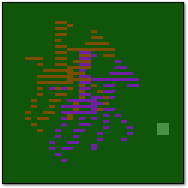 CS: That was the Polo game. The way that came about was that Atari had been bought by Warner Communications. Warner Communications owned Ralph Lauren, and Ralph Lauren was coming out with Polo cologne, so they wanted to do a tie-in. It was going to be introduced in Bloomingdale’s department store in New York City. They wanted to have Atari 2600 consoles dotted around the store playing a polo game.
CS: That was the Polo game. The way that came about was that Atari had been bought by Warner Communications. Warner Communications owned Ralph Lauren, and Ralph Lauren was coming out with Polo cologne, so they wanted to do a tie-in. It was going to be introduced in Bloomingdale’s department store in New York City. They wanted to have Atari 2600 consoles dotted around the store playing a polo game.
I was assigned to do this Polo game and they wanted a fairly detailed looking polo figure that was recognizable. I think it was Dave Crane that came up with the idea. We call it the “closed Venetian blinds player” because the player is 8-bits wide, so you shift the player back and forth seven pixels on alternate lines.
BE: I was just playing it on an emulator before this interview and I noticed that. Why did you do it that way?
CS: To get a wider player with more detail. In an alternate frame, we filled in the other line, so it kind of flickers. It probably wasn’t the best technique. In fact, it probably would have been better not to do the flickering. Anyway, that’s what we did.
BE: What happened to that game?
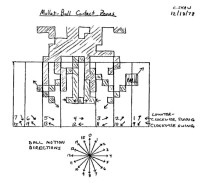 CS: We shipped off a few prototype cartridges and handwritten instructions for the event in New York City, but I never got any feedback. Did they actually use it? How did it go?
CS: We shipped off a few prototype cartridges and handwritten instructions for the event in New York City, but I never got any feedback. Did they actually use it? How did it go?
And Atari decided not to release the game. The Polo brand from Ralph Lauren was popular, but it’s not really a popular sport, so the game wasn’t released until years later. There was this CD that I have here — Stella Gets a New Brain, the Starpath Supercharger game collection.
BE: I remember that.
CS: These guys contacted me, and they wanted to use Polo as a bonus game on that disc. There was a small Atari office in Sunnyvale at that time, so we contacted them. I had one ROM that I had saved, so my husband took that EPROM to Xerox PARC, where he was working, and duplicated it and got the binary. I made a binary file, and we took that into the Atari office to show them. They gave the permission for it to be released on the CD. Of course, once the CD was released, the binary was out there.
BE: That’s why I have it now. It’s funny how far they travel.
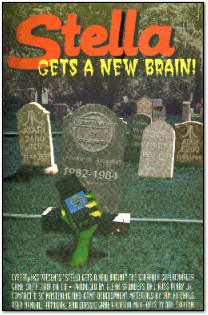 CS: [laughs] Yeah. I thought it was amusing that it has now became this rare, valuable prototype because the game was never released.
CS: [laughs] Yeah. I thought it was amusing that it has now became this rare, valuable prototype because the game was never released.
I have the one original ROM. I don’t know what happened to the other ones that I shipped off. It’s good that I saved these things, because otherwise, it wouldn’t have been preserved.
BE: Were you specifically hired to be a game designer at Atari?
CS: Yeah, I was hired to be a game designer.
BE: And a game designer was always a programmer at that time, right?
CS: In those days, one person would do the entire game: the design, the programming, the graphics and sound. Then you’d get feedback from the other designers, but basically one person did the whole thing.
BE: What was your job title?
CS: Let’s see. I did print out my resume here. For Atari, the title is “Microprocessor Software Engineer.”
BE: That sounds pretty impressive.
CS: Yeah.
BE: Especially for 1978. Was that the year you made Polo?
CS: I started out in August and it took two or three months to program. A two kilobyte program, and of course, [the Atari 2600 included] only 128 bytes of RAM.
BE: What was the atmosphere at Atari like at the time you worked there? Was it a nice place to work?
CS: Yeah. Well, at first it was fun — doing games — they had a game room with all the coin-op games where you go at lunch hour and play all the coin-op games.
BE: What was your office like at Atari when you were a game designer there?
CS: I shared an office with a guy named Ian. I’ve forgotten his last name. And then we had lab space. The offices had windows, and the lab was in the middle of the building, so you’d work on — at some point, we got a Tandem computer where we could type in the programs.
So you’d work on writing your code, and then you’d go in the lab and test it out on the test system and debug it, and so on. And we had 8-inch floppies that we had the programs on.
BE: Did you have a terminal in your office, or was it a full-blown computer?
CS: I got a terminal that connected to the Tandem mainframe. I’m not sure if we had that when I first started, but eventually we had a terminal. So no personal computers or anything.
BE: How many test machines did you have in the lab?
CS: There were quite a few. I don’t remember exactly.
BE: Would they load the program off the disk, or did you have to put the game on an EPROM first?
CS: No, we didn’t have to put it on an EPROM. We had some sort of home grown development system where you’d load from the 8-inch floppy disk and download it into this development system that had a terminal that you could debug on.
You didn’t have to burn a ROM every time you tested something. You’d just use this development system they had. It had a television set to display it on, and you could modify your program. You could directly hand assemble minor changes without having to reassemble the whole thing if you just wanted to test out some small change.
BE: When you were at Atari, did you witness any tension between Atari veterans who’d been there for a long time and the Warner management that came in?
CS: Yeah, there was the Activision split. Atari wanted to emphasize the brand name of Atari. They didn’t want to give the game designers any recognition as far as putting their names on the cartridges, and so on. I guess there was a thing they’d say, “You know, these game designers are just a bunch of high-strung prima donnas.” So somebody made t-shirts: “Just another prima donna from Atari.”
BE: Did you enjoy working with any particular people at Atari? Did you collaborate with any designers?
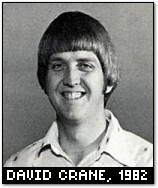 CS: Dave Crane had a lot of good ideas. He was the one that came up with the Venetian blind technique, although they used something similar in the chess game that Bob Whitehead was working on. I worked with the people that split off and formed Activision — you know, Dave Crane, Bob Whitehead, Larry Kaplan, and Al Miller, and there were some others there too.
CS: Dave Crane had a lot of good ideas. He was the one that came up with the Venetian blind technique, although they used something similar in the chess game that Bob Whitehead was working on. I worked with the people that split off and formed Activision — you know, Dave Crane, Bob Whitehead, Larry Kaplan, and Al Miller, and there were some others there too.
BE: When those guys left to form Activision, why didn’t go with them?
CS: I didn’t know that they were going to leave Atari to start Activision. It wasn’t until I left Atari and went to work for Tandem Computers that Activision offered me a job.
BE: When you designed a video game at Atari, did you sketch things out on paper or did you just start in your head and start programming? How did that work?
CS: The graphics we would draw on graph paper. Nobody had developed any sort of thing to do it on the computer, so you’d just draw your thing on graph paper and then hand code it into the right hex values. I guess I would hand write my code [on paper] and then type it in and because we didn’t have screen editors that would edit the text at that point, we just had line editors — those fairly tedious things.
BE: I can imagine. What were your hours like at Atari?
CS: I worked pretty standard eight hour days. I don’t remember what time I started. They had flexible hours. I didn’t work really long hours. I rode my bicycle to work, so I didn’t like to stay really late. During the winter, I would bicycle home in the dark, but I wouldn’t want to bicycle home really late, so I liked to work fairly standard hours.
BE: Did you live near Atari headquarters?
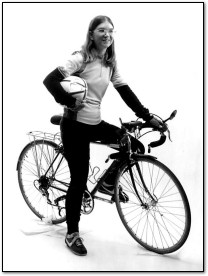 CS: Going to Atari was about a 10 mile bike ride.
CS: Going to Atari was about a 10 mile bike ride.
BE: That’s pretty far.
CS: It’s about the longest commute that I’ve done by bicycle, so I was in pretty good shape at the time.
BE: Were you living alone at that time?
CS: I was living with my husband, Ralph Merkle, in Mountain View.
We had met in 1976 at Berkeley in CS111 — Computer Science System Simulation — and we lived together for a while before getting married. He noticed I beat him on the midterm, so he became interested. And then he went to Stanford, doing his public key cryptography work.
I hadn’t actually finished the master’s degree when I started at Atari, because I had to do a project that I hadn’t finished yet. But I told Atari that I was going to get this degree. I had finished the coursework.
I completed the project using this homemade terminal that Ralph had built from a kit. It had a keyboard that kind of bowed down in the middle when you pressed on it. You had to buy a particular brand of black and white TV and modify it to connect to this terminal. I would dial up to Berkeley and work on my project.
I did finish the degree and it was granted in ’79. Ralph and I married in 1983.

Game Development At Atari
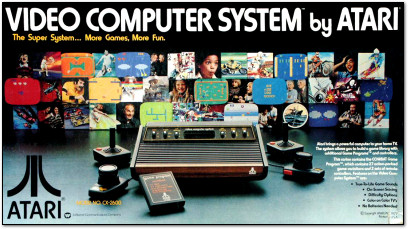
BE: What were the biggest challenges you faced in programming the Atari 2600?
CS: I suppose you know that it was a very difficult machine to program. Because you actually had to generate each line of the display, line by line, and count how many cycles every instruction would take, and — what was it? — 76 instruction cycles per line — and you could do a wait-for-sync instruction if you had a few cycles left over at the end of the line. You could issue a wait-for-sync and wait for the next line to start, so it didn’t have to be exactly 76, but sometimes you’d just go through and count and have exactly the right number of cycles.
It was very difficult to program, but that also made it very flexible, so [Atari was] able to do a lot more with it than they ever thought they’d be able to. It was originally only designed to do Tank and Pong and a couple of other things.
BE: And then people invented new techniques to do more sophisticated games.
CS: And they did bank switching. Originally, you could only do 4 kilobytes [of ROM space]. More than that, and you’d have to do bank switching. Then they had that Supercharger that had extra RAM in it that gave it a lot more flexibility because then you could just read your whole display out of RAM. I never worked on that. I did 3D Tic-Tac-Toe and Checkers with only 128 bytes of RAM.
BE: Which one did you do first: Video Checkers or 3D Tic-Tac-Toe?
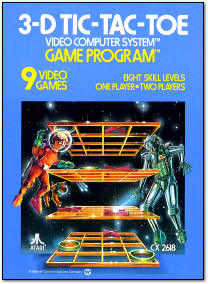 CS: 3D Tic-Tac-Toe. I must have started that in ’78 — ’78 to ’79 and I’d say it took about six months or so. They did have a board game called Qubic that was basically 4x4x4 Tic-Tac-Toe, so I guess I got the idea from that.
CS: 3D Tic-Tac-Toe. I must have started that in ’78 — ’78 to ’79 and I’d say it took about six months or so. They did have a board game called Qubic that was basically 4x4x4 Tic-Tac-Toe, so I guess I got the idea from that.
BE: Was it your idea to begin with?
CS: I don’t know how I came up with the idea of doing this as a video game, but it was my idea. Of course, programming the computer player was an interesting challenge.
BE: It seems like it would be hard to program computer AI on such a limited machine.
CS: Yeah, and that was only 2 kilobytes of ROM. We didn’t display the board at the same time the computer was computing the next move.
BE: I noticed. Why is that?
CS: For one thing, you don’t have enough RAM to do both. The other is that trying to maintain sync is pretty difficult while your doing the computations. Maybe it would be possible, but it would really slow it down. You’d be spending most of your time displaying the board, and then you’d only have the vertical blanking interval to do your computations. I don’t know if it would have been possible or not. The same thing was done in the chess game — just change the background color once in a while, do your computations, and when you’re done, put the board back up.
BE: Did anybody help you with 3D Tic-Tac-Toe?
CS: Ralph found a paper about it where somebody had proven that the first player could always win if they played a perfect game. They had done this with the aid of a computer. It also took advantage of symmetry: it doesn’t matter which outside corner you play. All eight outside corners are the same.
 Every once and a while, the computer would ask him what move to make, and he would help the computer make a move. He proved through this exhaustive process that the first player could always win by doing a table lookup to choose the next move. There wasn’t room to put that table in [3D Tic-Tac-Toe’s] two kilobyte cartridge, plus it would have been boring if the computer always played the same way from the table lookup.
Every once and a while, the computer would ask him what move to make, and he would help the computer make a move. He proved through this exhaustive process that the first player could always win by doing a table lookup to choose the next move. There wasn’t room to put that table in [3D Tic-Tac-Toe’s] two kilobyte cartridge, plus it would have been boring if the computer always played the same way from the table lookup.
BE: That’s true.
CS: I wanted to have a certain amount of randomness to how the computer played. I just ended up doing tree search. You have a certain number of possible moves and your opponent has a certain number of possible counter moves to those moves, and then you get this tree that gets ever-larger if you look more moves ahead.
BE: Did you have a selectable difficulty that looked deeper in the tree?
CS: There were eight levels, so basically it would look one more move ahead at each of the eight levels. Starting with one move look-ahead, then going to eight. That paper said that the strongest squares to play in are the eight outside corners and then the eight middle squares. So it would start by playing in those squares. Other than that, it was just a straight look-ahead.
BE: Was 3D Tic-Tac-Toe the first shipping game you ever designed?
CS: Yes.
BE: How did it feel to see that game completed? Did you go to a store to see the box and buy a copy?
CS: Well, I don’t know, I didn’t go to the stores that much. I remember later when I was interviewed for one of the magazines at Activision, I’d go to the store and say, “Oh, there’s the magazine with my article in it.”
BE: But you didn’t do that for your games?
CS: No, not too much. We’d get a copy of the game from Atari. At Activision, every time a game came out, they would give everybody in the company a copy of the game. So I have all the Activision games from the beginning to when I left the company. I saved all those. I saved the boxes. Somewhere, I have the instruction booklets. I haven’t found them yet.

Video Checkers
BE: What made you choose Video Checkers as your next project after 3D Tic-Tac-Toe? Was it your idea to do checkers?
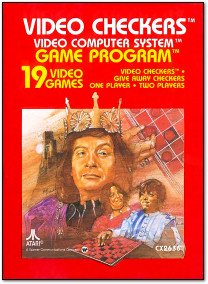 CS: Yeah. I guess because Bob Whitehead was doing [Video] Chess, I thought checkers looked like an interesting thing to work on.
CS: Yeah. I guess because Bob Whitehead was doing [Video] Chess, I thought checkers looked like an interesting thing to work on.
I didn’t know that Al Miller was doing Checkers at Activision at the same time that I was doing it at Atari. We both talked to Professor [Arthur] Samuel at Stanford, because he’d been working on computer checkers. Samuel did not let on that he was talking to both of us.
BE: That’s probably to his credit.
CS: Yeah. We were working independently. There’s also this more sophisticated algorithm than what I did for 3D Tic-Tac-Toe. I mean, there are obvious strategies like you try to advance your checkers and make them into kings, and we also tried to control the center of the board. There are various ways of rating the state of the board.
I also did alpha-beta pruning. Instead of searching every possible move, if you’re going down one branch of the tree, you say, “This branch is obviously not going anywhere and it’s not as good as this other branch.” So you would not continue down that branch — you’d prune it off and stop searching there. That sped it up quite a bit.
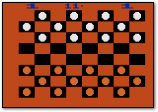 So that was a lot more sophisticated algorithm. I had 4 kilobytes [of ROM space on the cartridge] and Al did his in 2 kilobytes. I was pretty much done with that and somebody got a hold of the binary for Al’s game at Atari. We entered it in the development system at the lab and I looked at it. I don’t think I actually made any changes based on that.
So that was a lot more sophisticated algorithm. I had 4 kilobytes [of ROM space on the cartridge] and Al did his in 2 kilobytes. I was pretty much done with that and somebody got a hold of the binary for Al’s game at Atari. We entered it in the development system at the lab and I looked at it. I don’t think I actually made any changes based on that.
BE: What did you think of his version? Did you say, “Oh crap, somebody has made another checkers game?”
CS: I’d sort of gone for the checkering crown motif and he’d gone for making 3D-looking checkers that you stacked up, so I thought that looked neat. He also managed to maintain vertical sync. He didn’t display the board, he would just display a black screen and maintain the sync so when the screen came back up it wouldn’t roll or anything. Then I played my game against his game.
BE: Who won?
CS: Given about a similar amount of computation time, mine could beat his. I was pleased at that.

Other Projects at Atari
BE: After Checkers, what did you work on at Atari?
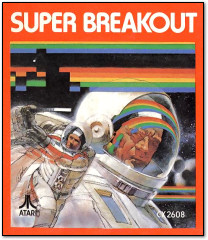 CS: Then I worked on the display for Super Breakout. Super Breakout was a coin-op game and they wanted to convert it to the Atari 2600, so I figured out how to do the display for that. You could have up to three balls in motion, so I used the ball and two of the missiles to do three balls and then you could add the bricks scrolling down the screen.
CS: Then I worked on the display for Super Breakout. Super Breakout was a coin-op game and they wanted to convert it to the Atari 2600, so I figured out how to do the display for that. You could have up to three balls in motion, so I used the ball and two of the missiles to do three balls and then you could add the bricks scrolling down the screen.
There are different variations, so I basically did a proof-of-concept that showed that it could be done before I left Atari. I didn’t finish the game; somebody else finished it. In fact, I met him years later. I can’t remember whether he said if he used my code — I’m sure he looked at it, anyway. I also did the graphics for the Othello game that Ed Logg did.
BE: Did you do anything for the 8-bit computer line?
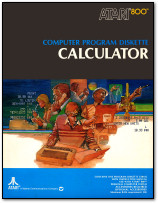 CS: I did 3D Tic-Tac-Toe for the Atari 800 — the computer. I also did a calculator for the 800. It wasn’t a game.
CS: I did 3D Tic-Tac-Toe for the Atari 800 — the computer. I also did a calculator for the 800. It wasn’t a game.
BE: Was it released?
CS: Yeah, it was released. I think it was on a floppy. I still have a sealed box.
It’s called Calculator. Basically, we bought a handheld programmable calculator that had financial functions and scientific functions, and so you would be able to program this thing. It would have been better if we had licensed VisiCalc and put a spreadsheet on the computer. That would have really made it popular. But we didn’t do that. I did this calculator thing. It did ship — I have one of them.
BE: Did you work on anything else at Atari before you left?
CS: I think that’s all I worked on at Atari.
BE: So you were there from 1978 to 1980?
CS: Almost two years.

Leaving Atari for Tandem
BE: What made you want to leave Atari and go somewhere else?
 The game industry is continuously going through these boom and bust cycles, and I guess toward the end there was sort of a mini-bust — I mean, before the big bust around ’83 or so, there was a kind of mini-bust where they were laying off people and writing memos about wasting paper clips and stuff like that. [laughs]
The game industry is continuously going through these boom and bust cycles, and I guess toward the end there was sort of a mini-bust — I mean, before the big bust around ’83 or so, there was a kind of mini-bust where they were laying off people and writing memos about wasting paper clips and stuff like that. [laughs]
During these bust cycles, things would get more stressful and not as fun. I had worked with a guy named Larry Gray at ESL and then muPro, and he had gotten a job at Tandem Computers. He called me up and said, “Hey, how’d you like to work for me at Tandem?”
Atari wasn’t as fun as it used to be, so I went over there.
BE: Were there any particular reasons why you wanted to leave? Or was it just the general climate of the company?
CS: I think it was the general climate.
BE: Did you get the sense that Atari didn’t appreciate its programmers?
CS: It wasn’t like they made a big deal of it. I think some of the unrest happened later, probably after I left.
BE: Did you go to Tandem because it paid more?
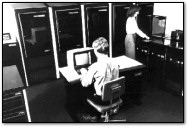 CS: I think they probably did pay somewhat more, but I don’t think that was the major factor in it. It was just, “I’ve done games for a while. Let’s try something different.”
CS: I think they probably did pay somewhat more, but I don’t think that was the major factor in it. It was just, “I’ve done games for a while. Let’s try something different.”
BE: What did you do at Tandem?
CS: They had a 68000-based service processor — a board that plugged into the mainframe that diagnosed the mainframe and brought it up. And they had a kernel or OS already written for it in assembly language. Some of the programming was done in C, but they needed somebody to do assembly language for the parts that had to run really fast, like the interrupt handlers for the console terminal and the modem and some of the other devices. I was the one that knew assembly language and could do that.

Joining Activision, River Raid
BE: How did you get started at Activision?
 CS: I was only at Tandem about 16 months before Activision called and said, “How’d you like to come work for us?” Since I worked at Tandem, that meant that I could then get hired by Activision, because Activision got sued by Atari and they had an agreement not to steal people away from Atari.
CS: I was only at Tandem about 16 months before Activision called and said, “How’d you like to come work for us?” Since I worked at Tandem, that meant that I could then get hired by Activision, because Activision got sued by Atari and they had an agreement not to steal people away from Atari.
BE: Do you remember who called you?
CS: I think it was Al Miller. I think he was impressed by my checkers game.
BE: I wonder if they knew that your checkers game could beat theirs.
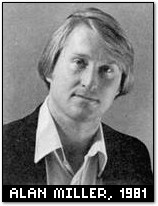 CS: I don’t know. I played mine off against various other checkers games. There was something called a VideoBrain or something I played it against also.
CS: I don’t know. I played mine off against various other checkers games. There was something called a VideoBrain or something I played it against also.
So he called me up, and I interviewed, and they offered stock options. They said, “Your stock options could be very valuable.” And I thought it might be fun to get back into video games.
BE: What year did you join Activision?
CS: I started there at the very beginning of 1982, so I interviewed in ’81.
I figured that as long as I was interviewing with them, I should also interview with Imagic, which was located in Saratoga [California]. So I went over there. But they said, “You haven’t really done any action games.” So they did not make me an offer.
BE: Imagic was only interested in action games?
CS: Yeah, because I don’t think the board games sold all that well. It’s an interesting programming project, but I don’t think they were big sellers. Although Atari would never actually tell us how the games did. We didn’t really get any feedback.
BE: Did that have anything to do with why you worked on River Raid next?
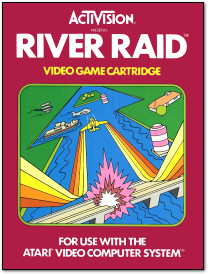 CS: Yeah. I said, “Well, gee, action games. Action games should be good.” River Raid was actually inspired by a coin-op game called Scramble. It was a space game. So I went to Al Miller and said, “I’m thinking of doing this space game.” He said, “There’s too many space games. Try to come up with something different.”
CS: Yeah. I said, “Well, gee, action games. Action games should be good.” River Raid was actually inspired by a coin-op game called Scramble. It was a space game. So I went to Al Miller and said, “I’m thinking of doing this space game.” He said, “There’s too many space games. Try to come up with something different.”
I wanted to do a scrolling shooter game, so I was drawing on the graph paper and saying, “If I use the playfield for the graphics, that’s 4 pixels wide, so scrolling horizontally would not work very well. It’d be very jerky.” So I said, “I’ll scroll vertically,” because you can scroll one line at a time, and the line is about half a pixel, so that’s much smoother motion.
The other thing was that the playfield, if you don’t change it on the fly in the middle of the line, then you can either have the left half of the screen identical to the right half of the screen or you can have the left half be a mirror image of the right half. I was doodling on the graph paper and said, “Oh, I could make it a mirror image, so it looks like a river with islands in the middle of it.” That’s where I came up with the river theme.
The first section is just straight. The banks of the river are straight and then you go to this section where it branches out and you can go either left or right around an island and that could be a river.
At first, your player was a boat. It wasn’t a jet. It was a boat, but my boat did not look very good. So I said “How about an airplane or jet? A jet looks good, so I’ll make it a jet.”
BE: Was it your idea to change it to a jet?
CS: I think I made an airplane that was not a jet and maybe Dave Crane said a jet would be better.
BE: Did you ever explain why the jet would crash into the riverbank when it was flying overhead?
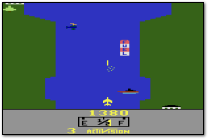 CS: Yeah, that was sort of illogical — unless you’re going up a canyon or something. In the Atari 800 version, I had sort of a brown canyon wall area. But it looked better with a jet. I guess I was going more for making a good visual and good gameplay rather than realism. [laughs]
CS: Yeah, that was sort of illogical — unless you’re going up a canyon or something. In the Atari 800 version, I had sort of a brown canyon wall area. But it looked better with a jet. I guess I was going more for making a good visual and good gameplay rather than realism. [laughs]
BE: You know, it never bothered me. I just thought of it now — that you could crash…
CS: …crash into the riverbank. And why is it that these planes flying across horizontally hit you but don’t hit the riverbank? I don’t know. [chuckles]
BE: I’ve heard that your technique for generating the River Raid maps was very unique. How did you do that?
CS: It was only 4 kilobytes of ROM, so you don’t have space to store a lot of graphics, so I just had graphics of the various transitions between a river of a certain width going to the next width. It was divided up into 32-line sections and I used a pseudorandom number generator to decide what the next width was going to be. So basically, you do a couple of shifts and an add or something and generate the next pseudorandom number, and that decides what the next part of the river is going to look like.
I’m sure I got the idea of pseudorandom numbers from somebody else. It had been used to generate the placement of objects but not to generate the landscape.
BE: A pseudorandom generator is where you can give it a certain seed number and it’ll generate the same numbers every time while appearing random, right?
CS: Yeah. Basically, if you start with the same seed every time, every time you play the game, it will look the same.
BE: And River Raid was the same every time, right?
CS: Yeah, but you could go a long time playing before you would repeat something you had done earlier on.
BE: How did you adjust for the difficulty level as the game progressed?
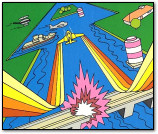 CS: I guess I would allow the river to get narrower and then also I would have fewer fuel tanks. I’d keep track of what level you were on and then, based on the level, that would determine how often you had fuel tanks instead of some other objects that you could run into and shoot. In the 800 version, I added in these [military] tanks that would shoot at you and balloons and stuff.
CS: I guess I would allow the river to get narrower and then also I would have fewer fuel tanks. I’d keep track of what level you were on and then, based on the level, that would determine how often you had fuel tanks instead of some other objects that you could run into and shoot. In the 800 version, I added in these [military] tanks that would shoot at you and balloons and stuff.
BE: So you had a way of tinkering with the pseudorandom outputs to make the river more narrow if you wanted?
CS: There are various algorithms as far as how narrow you would — At a certain level, you would permit it to get to a certain narrowness. I mean, I didn’t change the random number, but I guess there were just restrictions on how narrow I would allow it to get. I don’t remember the exact details.
BE: What kind of computer did you use to program River Raid?
CS: For development, I think we had some sort of DEC [computer]. They were still using line editors, and I had used this screen editor when I worked at Tandem, so I insisted that I had to have a screen editor. We would get in arguments about, “You know, actually, the line editor is faster and better and…” [laughs]
But they did get a screen editor for me for the DEC computer and that was pretty slow — it wasn’t as fast as they are nowadays. I preferred to use that so you didn’t have to say, “OK, type the next 22 lines of my program.” You could just page through.
BE: Did anybody else work on the design of River Raid?
CS: Let’s see, it was pretty much a one-person game. The other people would make suggestions. At first, I had it so each level of the playfield would be a different color, so I had various psychedelic colors and they suggested, “Just make a green playfield, because that’s more realistic.”
I think what happened was…I announced I was done with River Raid, but then the senior game designers, you know, the founders, said that they thought it needed more work. The thing was that I crammed the code down as much as I could to fit into the 4K, so it was hard to make any changes to it.
In fact, I had even done bad programming practices. I overlapped a color table with the beginning of the following subroutine. So I actually used the opcode from an instruction at the beginning of the subroutine as a color value. That’s how tight on space I was. I couldn’t figure out how to fit anything more in.
You get to the point where you’ve been looking at your program for so long that you just can’t see what else you can do with it. So to get a fresh pair of eyes to look at it, I asked Al Miller to look at it, and he found a way where I could save some more bytes, make a few changes, and get it to a point where it was acceptable for release. I can’t remember if that’s the point where I changed the background color or if I did that earlier. I actually have one of my preliminary versions where it has the psychedelic background colors. I actually have the ROM of that.
BE: Once River Raid launched, what was the reception like? Did you read any press reviews of it?
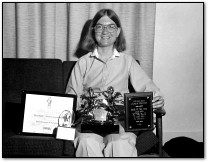 CS: It was certainly my most popular game. It launched right after Christmas in…’82? And then I went to the Consumer Electronics Show in Las Vegas at the beginning of January.
CS: It was certainly my most popular game. It launched right after Christmas in…’82? And then I went to the Consumer Electronics Show in Las Vegas at the beginning of January.
I remember one time I was getting in the elevator in the hotel. The elevator door opened and there were a bunch of Activision salesmen there. They all started applauding. [laughs]
BE: Because it was such a big hit for Activision?
CS: Yeah. They had a big cash bonus, a good salary, and we also got a company car. So I had my Audi 5000 Turbo that I got.
BE: Are you willing to disclose how much money you made on that game or your salary at the time?
CS: Well, no… [chuckles]
BE: It’d be interesting to know. It might sound pitiful if you don’t adjust for inflation these days.
CS: Even by today’s standards it was pretty good. Considering it was 1982, it was really good. The cash bonuses were as big as the annual salary, I can say that much about it. That basically doubled your income — for a couple of years, anyway.
BE: What was it like working at Activision compared to Atari? Can you describe the atmosphere there?
CS: Let’s see, we had individual offices, so you didn’t have to share an office. But then there was still a lab space in the middle, so you would interact in the central working area in the lab. I guess Activision wanted to make the game designers the stars, so they put your name on your game.
BE: Was that something that appealed to you?
CS: Yeah. Getting recognition was good.
BE: Were there any other woman game designers at Activision?
CS: I was the first. Later on they hired Carla Meninsky.

Happy Trails and River Raid Revisited
BE: After River Raid, what did you do at Activision?
CS: At some point I did River Raid for the Atari 5200 and 400 and 800. Although I think I started Happy Trails before then.
BE: Tell me about Happy Trails. It was for the Intellivision, right?
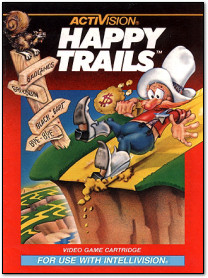 CS: Yeah. Happy Trails was inspired by this coin-op game called Locomotion. It was a sliding block puzzle game. Originally, I had race cars going around, but Dave Crane came up with the Happy Trails theme with the black and white hats walking around and picking up prizes.
CS: Yeah. Happy Trails was inspired by this coin-op game called Locomotion. It was a sliding block puzzle game. Originally, I had race cars going around, but Dave Crane came up with the Happy Trails theme with the black and white hats walking around and picking up prizes.
They have these plastic games with a 4×4 grid of numbers, or something, and you slide the numbers around and try to get them in order. It was similar to that, only you moved the blocks around and rearranged the path that your hat follows, then you pick up money bags and get points.
Dave Cane played this little tune on his little musical keyboard. He said, “This would be a good thing for the musical background.” I wasn’t that familiar with the Happy Trails music. I’d heard of Roy Rogers, of course, but it turned out [Crane] picked up the bass line from the Happy Trails song. Somebody brought in the sheet music, and I said, “Yeah, that’s the same as what Dave Crane gave me.” I agreed that basically it was the same. So they licensed the Happy Trails theme.
BE: Was it your idea to do a puzzle game after River Raid?
CS: Yeah.
BE: It’s interesting that you chose Happy Trails to follow-up one of the most popular Atari 2600 games of all time. Why did you switch to the Intellivision?
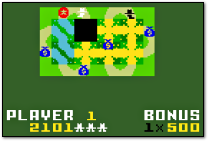 CS: I was ready to try something different, because I had been doing Atari 2600 for a long time. It was very difficult and limited in what it could do.
CS: I was ready to try something different, because I had been doing Atari 2600 for a long time. It was very difficult and limited in what it could do.
BE: Was the Intellivision easier to program?
CS: It was easier, so I figured out how to do this game on Intellivision. It would have been pretty hard to do on the 2600.
We could have a more detailed background [on the Intellivision]. You weren’t limited just to a couple of players, a couple of missiles, and a ball. You could have maybe eight sprites or something? I forget. And it had a built-in operating system. We had somebody reverse engineer that, but we didn’t use it much.
BE: After you did Happy Trails, did you work on anything else at Activision?
CS: I think the River Raid for the other systems was after Happy Trails.
BE: Tell me about River Raid for the Atari 800 and Atari 5200.
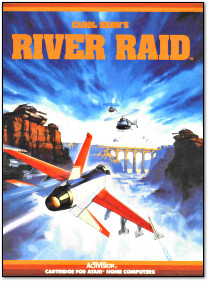 CS: The thing about that was I was under deadline pressure. They wanted it out by a certain date. [My husband] Ralph came up with this idea that, instead of just being the same graphics of the 2600, I could make it so if you went to the right, you would come up with an entirely different river than if you went to the left. It would just branch out indefinitely, sort of like how a river delta branches out when it reaches the sea, except it wouldn’t actually be possible in real life because you’d keep branching more and more the farther you went.
CS: The thing about that was I was under deadline pressure. They wanted it out by a certain date. [My husband] Ralph came up with this idea that, instead of just being the same graphics of the 2600, I could make it so if you went to the right, you would come up with an entirely different river than if you went to the left. It would just branch out indefinitely, sort of like how a river delta branches out when it reaches the sea, except it wouldn’t actually be possible in real life because you’d keep branching more and more the farther you went.
But I didn’t have time to implement that, so I implemented it pretty much like what it was on the 2600, except I shifted the background back and forth a little bit to make it look a little bit different and not just be entirely a mirror image on each side of the screen. They both used the 6502, so it was pretty much the same code ported over.
Peter Kaminski did the Intellivision version of River Raid, so I gave him the source code that I had, explained it to him a little bit, and he came up with the Intellivision version. Someone else did one for the ColecoVision, I think.
After Happy Trails, I was doing something for the ColecoVision. It was a graphical adventure game.
BE: Really? What was that called?
CS: I didn’t have a name for it. I didn’t finish. Basically, you’d see part of this giant underground maze on each screen, very detailed. And then you’d move from screen to screen, so you could only see part of it at a time. I had a horse that moved around, but it didn’t look very good. Basically a graphical adventure, it wouldn’t just be a maze. There would be more to it, but that was as far as I got. I guess I got sort of a writer’s block. I think I have a prototype of that too, somewhere.
BE: I’m sure there’d be some collectors interested in seeing that.
 CS: Mmm hmm. That was when the real bust in the video game industry happened. Activision went public, then shortly thereafter announced that they’d lost money in the previous quarter. So the stock price collapsed. I wasn’t able to sell my stock for six months after going public — that was part of the deal.
CS: Mmm hmm. That was when the real bust in the video game industry happened. Activision went public, then shortly thereafter announced that they’d lost money in the previous quarter. So the stock price collapsed. I wasn’t able to sell my stock for six months after going public — that was part of the deal.
And, you know, things got more stressful. I guess I had this idea of self-imposed pressure…if I could come up with another hit that would help the company. So it was kind of stressful and not as much fun as it used to be. There were layoffs and stuff. So I didn’t finish this game I was working on.
I took some time off, and then I went back to Tandem computers. They re-hired me to work on their service processor, their newest machine.
BE: So you voluntarily left Activision yourself?
CS: Yeah.
BE: Did you have anything to do with River Raid II?
CS: No, I didn’t do that. I heard about it. I don’t think I’ve actually played it, but I found it in one of the Action Packs. You have to land on an aircraft carrier or something, I forget.

Back to Tandem, Early Retirement
BE: After Activision, you went to Tandem again?
CS: Yeah. We were doing very reliable computers to run things like airline reservation systems and the New York Stock Exchange. It had multiple processors. It was basically non-stop. You’d pull out one of the processor boards and the computer would keep running.
BE: Can you give me a brief career summary from that point to the present?
CS: I worked for Tandem for another six years, so that was ’84 to ’90. Then my husband got this great job working for Xerox PARC — the Palo Alto Research Center. I did a financial analysis and said, “Gee, maybe I don’t have to keep working.” They had a lot of deadline pressure at Tandem too — you gotta get stuff out. Of course, my husband said, “You took those deadlines too seriously. Your schedule always slips.”
BE: Did you essentially retire early in 1990?
CS: Yeah, but with a new definition of retirement. You retire, but you end up doing volunteer work or working part time.
BE: What sort of volunteer work did you do?
CS: Among other volunteer work, I did various work for the Foresight Institute that eventually resulted in a part-time paid position as Chief Information Officer, maintaining the Macs and a Windows NT Server. I left that job in 2001.

Impact of Gender on Profession
BE: Let’s talk a little bit more about being a woman engineer while we have the chance. Did you have any difficulties in your career because of your gender?
CS: I wouldn’t say I really had any difficulties because of my gender. I mean, there was the one remark by Ray Kassar [laughs], but generally it wasn’t a problem.
BE: Was sexual harassment ever a problem for you?
CS: No, I never really ran into that. It didn’t seem to be a problem. Certainly, at Tandem, they had a lot of women working there. Woman engineers, and for a while my manager was a woman, so I didn’t really run into discrimination and harassment that I recall because of being a woman.
BE: Why do you think there are so few women working as programmers compared to men?
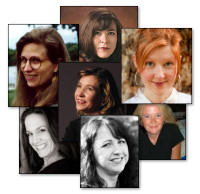 CS: I remember reading recently that actually the number of women went up for a while, reached a peak, and then it’s actually gone down. Their speculation is that girls don’t want to be perceived as being nerds and they don’t go into those fields. They can go into law and make more money doing that. Or other fields.
CS: I remember reading recently that actually the number of women went up for a while, reached a peak, and then it’s actually gone down. Their speculation is that girls don’t want to be perceived as being nerds and they don’t go into those fields. They can go into law and make more money doing that. Or other fields.
I was talking to someone recently. She said, in this area, they are teaching girls in elementary schools — girls and boys — how to program. So maybe in this area there’s less of a gender gap then maybe some other areas.
I have heard there are fewer women engineering graduates than there used to be a few years ago.
BE: Do you think your generation, going through the ’70s, was one of the first where women felt free to be engineers?
CS: Yes. We had the whole feminism thing, the women’s lib and stuff.
BE: Did that appeal to you at the time?
CS: Yeah, because I remember I had a sociology class in high school. You could pretty much do whatever you want. I was reading about women’s lib and stuff, getting into that.
I guess I was pretty much a loner, so I was used to working on my own. I was used to being one of the few women doing things. The people I worked with generally were not harassing or discriminatory. Maybe in some other companies there was some harassment.
BE: Do you think there is any biological difference between men and women that makes men more likely to be programmers than women? Perhaps the way that their brains work?
 CS: At the time, I was denying that there was any difference. I mean, there’s the obvious physical difference, but if you think about it, their brains could have developed differently, so I don’t really know. Certainly there are women that are capable of doing these things.
CS: At the time, I was denying that there was any difference. I mean, there’s the obvious physical difference, but if you think about it, their brains could have developed differently, so I don’t really know. Certainly there are women that are capable of doing these things.
BE: There are evolutionary psychologists who think that the gender roles evolved separately — for example, women might be better at communication than men, that kind of thing.
CS: Yeah, there’s always a question of nature versus nurture. How much of it is hereditary and how much of it the environment. We don’t really know.
BE: Do you think there’s something different about you as a woman that made you choose to be a programmer when a lot of women don’t?
CS: I guess just not really caring what other people thought about what I did.
BE: Would you say you have a natural predisposition for math and analytical things?
 CS: Yeah, I was good in math. I was good in math and science, and when I was a kid, I wasn’t that interested in dolls and things like that. I collected matchbox cars and I was into model railroading. My dad and my brothers started this model railroad, then I kind of inherited it, and kept working on it.
CS: Yeah, I was good in math. I was good in math and science, and when I was a kid, I wasn’t that interested in dolls and things like that. I collected matchbox cars and I was into model railroading. My dad and my brothers started this model railroad, then I kind of inherited it, and kept working on it.
I actually designed some circuitry for this model railroad with some transistors and stuff that would turn on the signal light for the various blocks showing there was a train up ahead. I was still working on that in high school and college even. Then I got into computers and lost interest in that.
BE: Do you have any sisters?
CS: I don’t have any sisters, so basically I grew up with two brothers. One was older and one was younger, so I was interested in doing what they were interested in.
BE: There are a lot more women in game development these days than in your time. Does that sound like a good thing to you?
CS: Of course it’s a good thing. It takes a whole production team — it’s like producing a movie now. So there’s room for different skills: the software, the graphics, the music, the design of the game, the story line, and everything. You have a huge team developing the game.
BE: What advice would you give to young women or girls who might want to choose a profession in computer science or game design?
CS: If that’s something they like doing, they should go ahead and do it. And not let people tell them that they can’t do it. The main thing is find something that you like doing and are interested in.

Legacy and Current Events
BE: What are you up to these days?
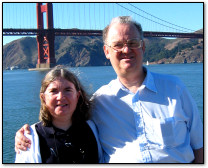 CS: I still bicycle, but not as much as I used to. Just easy rides about once a week. I spend a lot of time on the computer. I’ve been doing a slow migration from my old computer running Windows XP to my new computer running Windows 7 Ultimate. I’ve also been catching up on my reading. We have been cutting back on our magazine subscriptions as we spend more time browsing the Web, but we still receive quite a few magazines.
CS: I still bicycle, but not as much as I used to. Just easy rides about once a week. I spend a lot of time on the computer. I’ve been doing a slow migration from my old computer running Windows XP to my new computer running Windows 7 Ultimate. I’ve also been catching up on my reading. We have been cutting back on our magazine subscriptions as we spend more time browsing the Web, but we still receive quite a few magazines.
BE: How has being a video game designer changed your life?
CS: I guess it gave me the money to be able to retire at an early age.
BE: Was it your success with River Raid that let you do that?
CS: Yeah, that helped. We saved up some money. I got into investing, mostly in index funds.
BE: How do you feel about being a pioneering female video game designer?
CS: I haven’t really emphasized my game design background. I used to have a website, carol.com, and I didn’t put anything about video games on there. I’ve been in stealth mode for a while.
BE: Is there any reason for that?
CS: I guess I didn’t want a lot of fame or publicity. But I did do an interview — we all got together at Nolan Bushnell’s house in 1999 for the “Stella at 20” videotape and were interviewed for that. I think that was probably the last interview I did.
Then there was this “Stella Gets a New Brain” thing. Occasionally, people will contact me and say, “We want to release your game.” There’s also an “Intellivision Rocks” compilation of Intellivision games. It’s a CD-ROM.
They contacted me for that, and then there’s the Atari 2600 Action Pack that Activision put out. They put River Raid on that and they have a few remarks that I gave them. Since I was an employee of the company, I did not get royalties. Once I left the company, I didn’t get any more money for these various things.
BE: Have you designed any games since you left Activision?
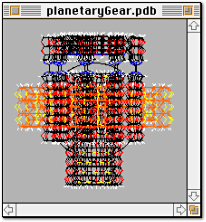 CS: No, I haven’t. I did this thing called the MASS project: Molecular Assembler Sequence Software. It was written in C++, and it was supposed to help with molecular modeling — to actually figure out how you would build something atom-by-atom.
CS: No, I haven’t. I did this thing called the MASS project: Molecular Assembler Sequence Software. It was written in C++, and it was supposed to help with molecular modeling — to actually figure out how you would build something atom-by-atom.
The preliminary version could display some of these bearings and gears that they had designed, but I never actually finished it. It was related to [my husband’s] nanotechnology work and to the Foresight Institute. Their slogan, at one time, was “Preparing for nanotechnology.”
BE: Did you keep up with the video game industry through the years after you left Activision? Have you played any video games since then?
CS: I really got into SimCity. That was a while ago.
BE: You play PC games?
CS: Yeah. My city got up to a population of 250,000, and it was supposed to turn in to megalopolis, but actually nothing happened at all. [laughs] I played The Sims a little bit, but I never really got into that.
BE: Did you play any video game consoles like the NES in the ’80s?
CS: Not really. One of my brothers has two daughters, so they played some of those games. I never really got into those — it was mostly just PC and Mac games. We played Myst. We solved that, and then the sequel was Riven, and we had to cheat a couple of times to solve that. I haven’t really done that much game stuff since I left Activision.
BE: So you haven’t bought any game consoles or played any home video games by yourself since then?
 CS: We played on my brother’s Wii system. It wasn’t as easy to control as I thought it would be. They make this big deal about their controllers.
CS: We played on my brother’s Wii system. It wasn’t as easy to control as I thought it would be. They make this big deal about their controllers.
BE: Have you ever considered designing games again?
CS: One thing I considered was designing games for smartphones because that looks like a really good market. There’s a lot of competition, but I gather a lot of the apps are fairly simple. If you could come up with a really well done app, you could make good money at that.
BE: Do you keep up with any of the Atari or Activision alumni these days?
CS: Every once in a while. We got together with Mike Lorenzen a while ago and had lunch. So it’s been a while. Al Miller went to another company that would have open houses. We would go to those, and that’s been a while. Occasionally, somebody will want to get in touch with somebody, and we’ll say, “If you want to talk to this guy…”
BE: Do you ever play the games you designed?
 CS: Recently, I was talking to somebody I know, and it turned out she liked 3D Tic-Tac-Toe, so we got started talking about the classic games and that got me interested in seeing if I could get it working on my computer again. So I bought a Stelladaptor and hooked up the Atari joystick, and then I used the emulator called Stella for Windows.
CS: Recently, I was talking to somebody I know, and it turned out she liked 3D Tic-Tac-Toe, so we got started talking about the classic games and that got me interested in seeing if I could get it working on my computer again. So I bought a Stelladaptor and hooked up the Atari joystick, and then I used the emulator called Stella for Windows.
BE: What did you think of your old games? Were you impressed?
CS: Yeah. I like River Raid. One thing I was wondering: I made it so when you move right and left, you actually accelerate right and left. You don’t move at a constant speed, and that makes people tend to ram right into the walls while moving sideways. I was wondering, “What if I had moved at a constant speed sideways?” But it might be that you couldn’t get through the tight spaces if you did that.
One of the big features of River Raid was that you could actually accelerate up and down, because in most of these scrolling shooter games, the landscape moved at a constant rate of speed. You could move your spaceship around the screen, but you couldn’t really accelerate or decelerate, but I made it so the landscape actually speeds up and slows down. I think that makes the gameplay a little bit better.
BE: Are there any misconceptions about your time as a game developer that you’d like to clear up?
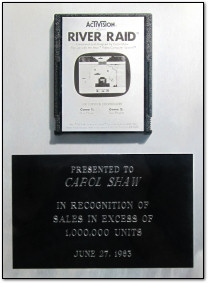 CS: One thing I read was that the senior game designers actually rejected River Raid originally, and that’s not how I remembered it. I remember they said, “It needs a little bit more work,” but they didn’t really reject it. They just said, “Do a little bit more work,” and it did eventually get released.
CS: One thing I read was that the senior game designers actually rejected River Raid originally, and that’s not how I remembered it. I remember they said, “It needs a little bit more work,” but they didn’t really reject it. They just said, “Do a little bit more work,” and it did eventually get released.
BE: Yeah, it definitely got released. There are a few million copies of it floating around now.
CS: They told me that they produced almost two million River Raid cartridges. I got a plaque — a platinum cartridge for one million sold. I have a similar one in gold for 500,000 units sold at an earlier date.

Carol Shaw Gamography
| Title | Year Published | Platform | Contribution |
| Polo | N/A (1978) | Atari 2600 | Design, Code, Art |
| 3D Tic-Tac-Toe | 1979 | Atari 800 | Design, Code, Art |
| 3D Tic-Tac-Toe | 1980 | Atari 2600 | Design, Code, Art |
| Video Checkers | 1980 | Atari 2600 | Design, Code, Art |
| Othello | 1980 | Atari 2600 | Art |
| Super Breakout | 1981 | Atari 2600 | Display Code |
| River Raid | 1982 | Atari 2600 | Design, Code, Art |
| River Raid | 1983 | Atari 800 | Design, Code, Art |
| River Raid | 1983 | Atari 5200 | Design, Code, Art |
| Happy Trails | 1983 | Mattel Intellivision | Design, Code, Art |
| Untitled Graphical Adventure | N/A (1983/84) | ColecoVision | Design, Code, Art |
—
If you enjoyed this interview, check out VC&G’s 2009 interview with Jerry Lawson, black video game pioneer.
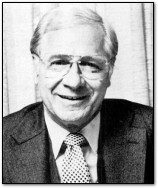
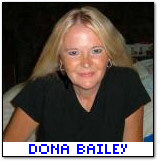
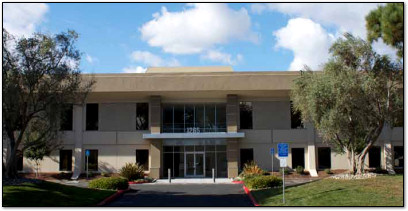


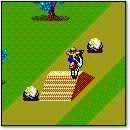
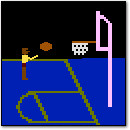
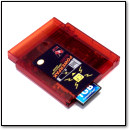
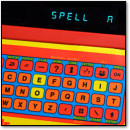
October 12th, 2011 at 4:54 pm
I’m sure Kassar was joking, but that was kinda sexist, and secondly (and more importantly), he was a horrible boss overall.
October 12th, 2011 at 8:40 pm
It would be really interesting if you could take your interviews, etc. and redo them in video and compile it into a history of vintage games documentary. It would be niche sure, but I would watch it.
October 13th, 2011 at 12:18 am
This was an amazing interview. Thank you so much!
October 13th, 2011 at 10:33 am
Very nice read. I had assumed (rightly) that it was a male dominated industry back then, more so than now; I had no idea any of the games I remember from back then were designed and coded by a woman. Neat!
October 13th, 2011 at 10:58 am
awesome reading. Thanks, Benj!
October 18th, 2011 at 2:04 pm
I love these long interviews! Keep ’em coming!
January 30th, 2012 at 2:42 pm
Great reading.
I remember playing this game for hours and hours with my brothers and mother on our ‘Wooden’ Atari 2600 when I was a little kid. It was definitely one of our favorite games.
Thank you Carol for creating this game!
February 10th, 2012 at 4:32 pm
thank you benj, this was great.
I think Carol and her “RIVER RAID” are one of the greatest hits in the industry.
my regret is: why she did not continue her programming to make more games and although more money.
February 11th, 2012 at 3:54 pm
Awesome interview to a great woman!
February 23rd, 2012 at 4:44 pm
Nice interview! Im you fan! thank you a lot for create this awesome game!
Someone know Carol email? Because Im trying to create a homebrew game like rive raid and I want some advices from her.
Best regards,
Vinicius
July 10th, 2012 at 10:58 pm
Great interview. Please keep them coming.
July 27th, 2012 at 7:46 pm
Please, post information about the RIVER RAID cover artists.
August 27th, 2012 at 12:14 am
Great interview. I just switched back to an old PS2 so I could play all of the turn based rpg’s for that system and I picked up a copy of the Activision anthology for 5 bucks, “river raid” and the soundtrack alone are worth the $5 . Carol Shaw created an all-time classic!
June 18th, 2013 at 4:16 pm
As a girl, I found this interview really inspirational. 🙂
March 3rd, 2014 at 7:00 pm
Great and thorough interview.
I really liked that her being a woman was never an issue either for her or her colleagues.
She was a programmer first and foremost.
June 19th, 2015 at 8:47 am
I am uncertain that Carol Shaw was the first female games developer: Joyce Weisbecker (daughter of Joseph Weisbecker, the designer behind the FRED games machine) coded a couple of games for her father’s machine during the 1973-1974 period.
Source: Retro Gamer issue 139 p51-52.
June 19th, 2015 at 11:12 am
Herbert,
Thanks for your comment. Sounds like Marty’s article on the Studio II may have finally been published. It’s a fascinating history that has never been told until now.
I have no doubt that multiple women somewhere in the world wrote or designed computer games before Carol Shaw. What distinguished Shaw was that she was Atari’s first known female full-time professional video game designer/developer, or as I said in the intro: “one of the world’s first female professional video game designers.” There is more history to be written on the subject, no doubt.
Of course, the main thing that distinguished Shaw, and why she deserves attention, is that that she was a brilliant game designer.
March 7th, 2017 at 10:16 pm
Thanks for this interview, Benj! Brazil loves Carol and River Raid! A great and inspirational history. I wrote an article about 30 YEARS OF RIVER RAID, at the follow link: https://filosofiashmup.blogspot.com.br/2012/09/ficamos-velhos.html
Note: your interview was translated to portuguese at this link: http://www.memoriabit.com.br/entrevista-com-carol-shaw-primeira-mulher-game-designer/
November 4th, 2019 at 8:10 pm
I am the surviving TIA designer from the Atari 2600.
I consider the top 4 ORIGINAL games for the 2600 to include:
– Pitfall! from David Crane
– Yars Revenge from Howard Warshaw
– Adventure from Warren Robinett.
– River Raid from Carol Shaw.
Why River Raid: vertical scrolling playfield.